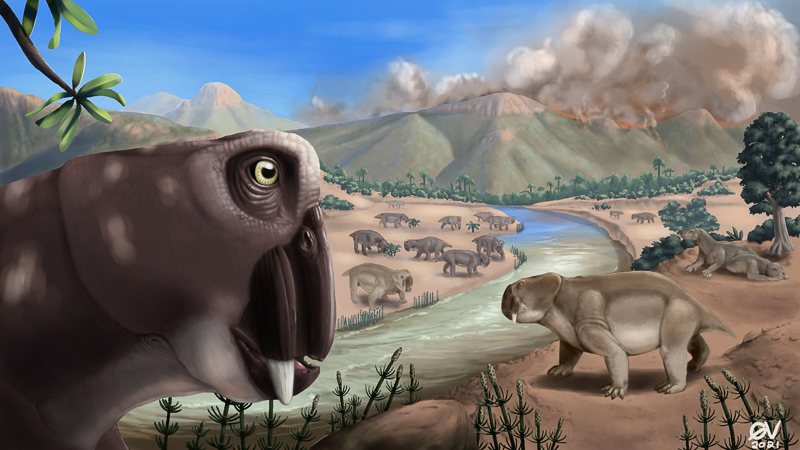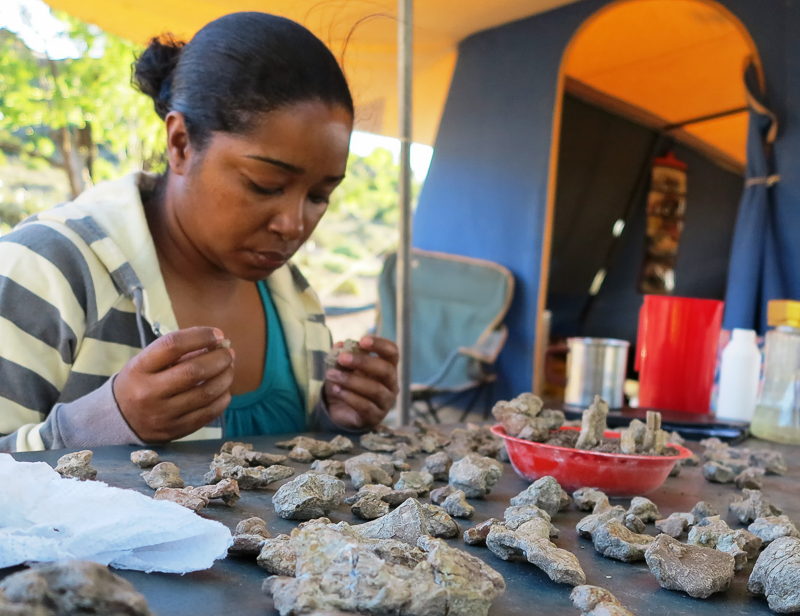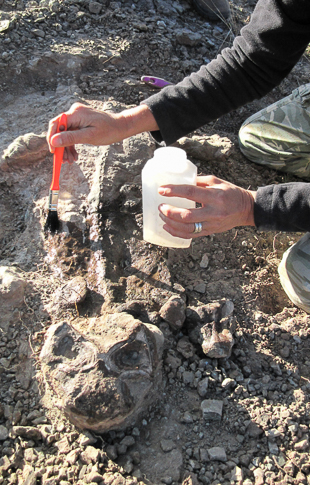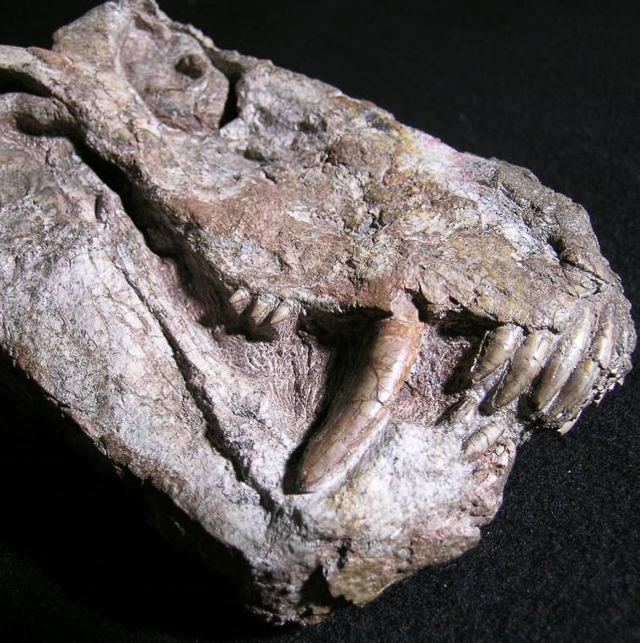Earth’s biggest mass extinction lasted much longer on land than in the sea
For immediate release ‐ April 19, 2021
Contact: Jon Pishney, 919.707.8083. Images available upon request

Our planet’s worst mass extinction event happened 252 million years ago, when massive volcanic eruptions caused catastrophic climate change. The vast majority of animal species went extinct, and by the time the dust settled the planet had entered the early days of the Age of Dinosaurs. Scientists are still learning about the patterns of which animals went extinct and which ones survived and why. In a new study in PNAS, researchers found that while extinctions happened rapidly in the oceans, life on land underwent a longer, more drawn-out period of extinctions.
“People assumed that because the marine extinction happened over a short period of time, life on land should have followed the same pattern, but we found that the marine extinction may actually be a punctuation to a longer, more drawn-out event on land,” says Pia Viglietti, a postdoctoral researcher at Chicago’s Field Museum and the lead author of the PNAS study.
Part of why scientists had looked to the marine extinctions for clues as to what happened on land is that there’s a more complete fossil record of life underwater. If you want to become a fossil, dying in the water, where your body will rapidly get covered by sediment, is a good way to make that happen. As a result, paleontologists have known for a while that 252 million years ago a mass extinction hit at the end of the Permian period, and within 100,000 years, more than 85% of the species living in the ocean went extinct.
“As the most devastating event in the history of life on Earth, the end-Permian extinction has attracted a lot of research interest, but much of that has been focused on the marine record. Its effects on terrestrial — that is, land-based — ecosystems are relatively poorly understood, in large part because there are so few fossil-bearing regions worldwide yielding terrestrial fossils of the right age,” says Christian Kammerer, one of the co-authors on the paper and Research Curator of Paleontology at the North Carolina Museum of Natural Sciences in Raleigh.
 Bethulie Canyon, Free State Province is a well-known collecting site of fossils from the Permo-Triassic Period within South Africa’s Karoo Basin. Photo: Pia Viglietti.
Bethulie Canyon, Free State Province is a well-known collecting site of fossils from the Permo-Triassic Period within South Africa’s Karoo Basin. Photo: Pia Viglietti.
To learn what happened to life on land, Viglietti, Kammerer and their colleagues examined fossils from hundreds of fossil animals that lived in what’s now South Africa’s Karoo Basin at the time of the mass extinction. The researchers created a database and separated the fossils by age, grouping together specimens by 300,000-year time intervals. This approach allowed the researchers to quantify the appearance and disappearance of different species and look at the bigger picture of life over time, rather than just relying on individual specimens to tell the whole story. Kammerer notes, “The Karoo record is remarkably complete, by far the best in the world for looking at the end-Permian extinction on land, and we have been able to assemble a data set of unprecedented scale and precision to examine the dynamics of this extinction in fine detail.”
 Zaituna Skosan, Collections Manager at Iziko Museum in Cape Town, South Africa, glues together a broken-up fossil during fieldwork in the Karoo Basin. Photo: Roger Smith.
Zaituna Skosan, Collections Manager at Iziko Museum in Cape Town, South Africa, glues together a broken-up fossil during fieldwork in the Karoo Basin. Photo: Roger Smith.
“Our approach unifies the data and says, okay, within this time bin we have these species, but as we go up, we have these other species,” adds Viglietti. “By applying sampling methods to these bins, we can help correct for issues like having more or fewer specimens collected in different time intervals or places. Ultimately, it lets us quantify how much extinction is happening and how quickly new species are appearing.”

RIGHT: A fossil of the dicynodont Lystrosaurus, a mammal relative that survives the end-Permian mass extinction event, is collected during fieldwork in South Africa’s Karoo Basin. Photo: Roger Smith.
One of the species that helped reveal patterns of extinction and recovery was Lystrosaurus, an herbivorous early mammal relative that ranged from the size of a small dog to a cow, depending on the species. “It had a beak and tusks, it wasn’t the most attractive animal, but I have a soft spot for Lystrosaurus because it was like the first animal I studied as a grad student, so coming full circle with Lystrosaurus in this study made me quite happy,” says Viglietti.
Lystrosaurus is what paleontologists call a “disaster taxon” — a group that thrived during a time when most other life was struggling. “Lystrosaurus is like a poster child for the end-Permian extinction that’s always been portrayed as this animal that flourishes in the aftermath of all this extinction and just takes over,” says Viglietti. “But we see Lystrosaurus appearing before the extinction even got started; it was already abundant. It got us thinking about what was driving that abundance — if Lystrosaurus just took over the barren landscape after other animals went extinct, or if the environment was changing and Lystrosaurus adapted to these changes that were causing extinction for all these other species. Our best guess is the latter.”
Examining fossils like Lystrosaurus showed the researchers that the end-Permian extinction looked very different on land than it did in the oceans — it was a much longer, more drawn-out affair. If the history of life on Earth were compressed into a single year and the end-Permian extinction killed 95% of the ocean’s animals in a matter of 14 minutes, the land extinction would have taken 10 times as long, about 2 hours and 20 minutes.
It’s not clear exactly why the mass extinction event happened so much more slowly on land. “The changes to the Earth’s climate were cumulative and added up over time. Ecosystems were slowly disrupted, and then it just got to a point where everything collapsed, like the straw that breaks the camel’s back,” says Viglietti. “Everything’s fine, until it’s not.”
One reason for the discrepancy could be that the oceans can absorb chemical changes and stabilize themselves, up to a point. “In today’s climate crisis, the oceans can absorb a lot of carbon dioxide or rise in temperature without people realizing, and then all of a sudden you get sudden ecosystem breakdowns like ocean acidification and coral bleaching,” says Viglietti. The same might be true for the late Permian oceans.
Understanding what happened in the end-Permian mass extinction gives us clues about the rise of the dinosaurs — many of the ancient mammal relatives went extinct, leaving ecological vacancies that dinosaur ancestors evolved to fill. But the end-Permian extinction also provides insights into the mass extinction event that the Earth is currently undergoing due to climate change and habitat destruction.
“The environmental changes that we are causing and the impacts we are having on animal and plant species are getting to the point where the scale is such that there isn’t really anything in human history that is comparable,” says the Field Museum’s Kenneth Angielczyk, senior author on the paper. “The fossil record can give us some idea of what massive biodiversity crises are like and how they proceed.”
“It takes a long time to recover from extinction. When we lose diversity, it’s not going to recover in our lifetime, it’s going to take hundreds of thousands of years, or even millions,” says Viglietti. “Studies like this one show what our society should be focusing on.”
 Skull of one of the large predators that died out in the end-Permian mass extinction.
Skull of one of the large predators that died out in the end-Permian mass extinction.

